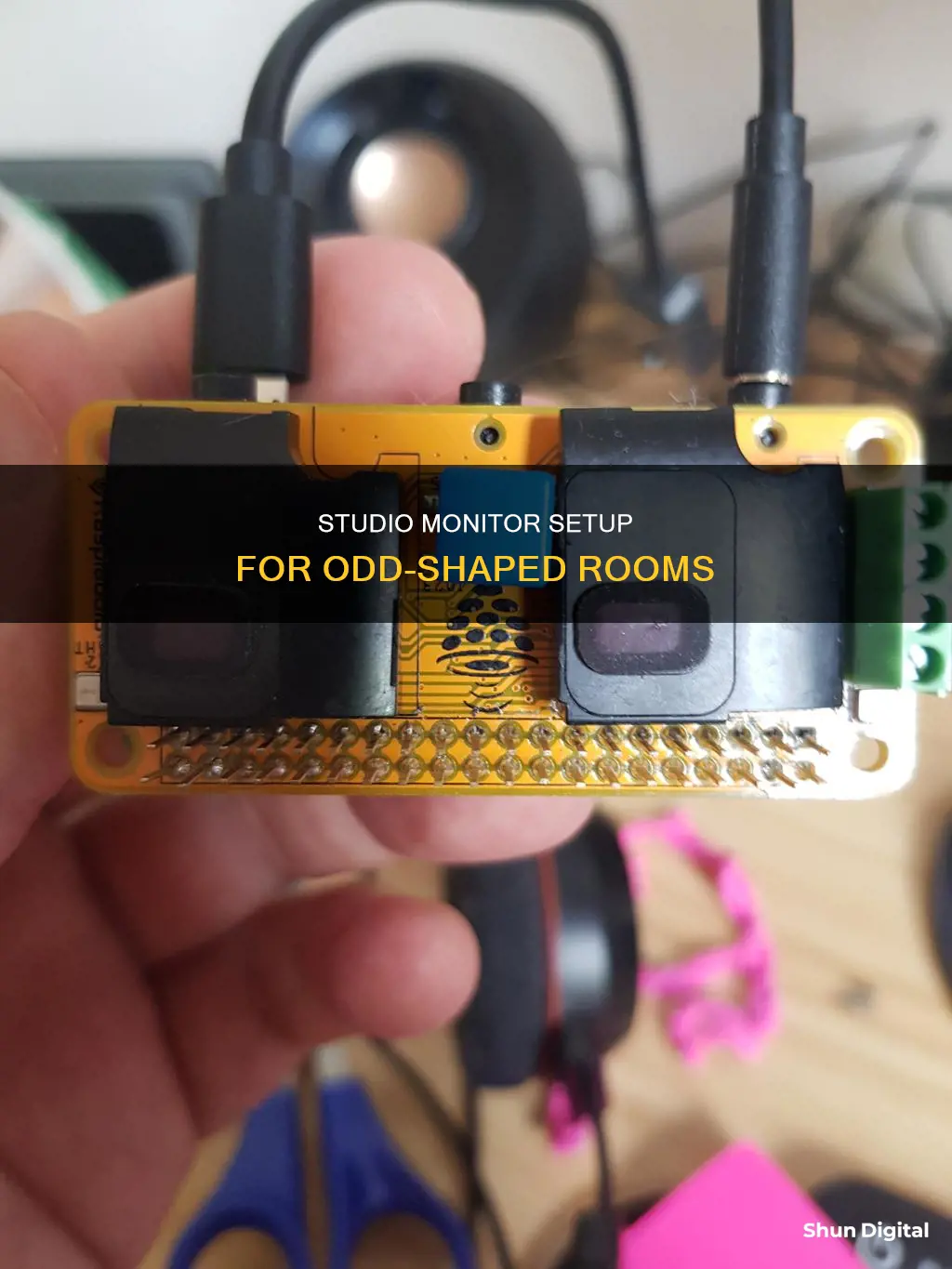
The placement of studio monitors in a room is crucial for achieving the desired sound quality and can be challenging in oddly shaped rooms. The key considerations for optimal monitor placement include symmetry, speaker height, and distance from walls. Symmetry is essential, ensuring that the left and right sides of the listening position have balanced acoustics. Speaker height should be adjusted so that the tweeters are at ear level for accurate sound perception. It is recommended to position speakers along the short wall of the room, angled to form an equilateral triangle with the listening position. Speakers should also be placed away from walls and corners to minimise acoustic issues. In oddly shaped rooms, such as L-shaped or curved rooms, treating reflective surfaces and using room correction software can help improve sound quality. Experimentation is often necessary to find the ideal speaker placement that delivers the best sound response.
What You'll Learn

Symmetry is key
When it comes to placing studio monitors in a room, the layout and symmetry of the space are crucial considerations. While the ideal placement depends on various factors, such as room shape and size, adhering to the principle of symmetry can help achieve optimal sound quality and mixing results.
The Importance of Symmetry
Symmetry in studio monitor placement refers to creating a balanced arrangement where the setup on the left and right sides of the listening position is mirrored. This means that the distance from the monitors to the respective side walls should be the same, and the surrounding environment, including windows, walls, and acoustic panels, should be evenly distributed. Striving for symmetry helps ensure that the stereo signal is not compromised and that you can make more informed decisions about the stereo image of your mix.
Tips for Achieving Symmetry
To achieve symmetry in an odd-shaped room, consider the following:
- Positioning Along the Short Wall: If the room is rectangular, it is generally recommended to position the monitors along the short wall, aiming them at the length of the space. This helps reduce reflections off the back wall and allows for better low-end frequency development.
- Distance from Walls: Keep your studio monitors away from walls and corners. The ideal mix position is approximately 38% of the room length from the front wall, about a third of the way in.
- Equilateral Triangle Configuration: Arrange the studio monitors and your listening position in an equilateral triangle, ensuring equal distances between the monitors and from each monitor to your position.
- Speaker Height: Adjust the speakers so that the high-frequency drivers are at ear height. This can be achieved by using monitor stands or shelves to raise the speakers to the appropriate level.
- Avoid Hard Surfaces: Acoustically hard surfaces, like windows and drywall, can cause sound alterations through reflections. Position your speakers away from these surfaces or use acoustic panels to diffuse the sound.
- Room Treatment: If one side of the room has a window, consider using acoustic treatment or curtains on the opposite wall to maintain symmetry and minimise sound reflections.
- Experimentation: Due to the unique characteristics of odd-shaped rooms, experimentation is key. Move the speakers to different positions and play test sounds to determine the optimal arrangement. Trust your ears and use your judgement to find the setup that sounds best to you.
Odd-Shaped Room Examples
For L-shaped rooms, placing yourself at the end of the longest point of the room is recommended. Additionally, treating side walls with acoustic panels can help avoid phase cancellation issues. For U-shaped or studio apartments with unique features, such as closets or windows, focus on maintaining symmetry between the left and right sides of the listening position. This may involve using room dividers or finding a position where the left and right walls from the monitors up to your head exhibit symmetry.
Fixing Color Bands on Your Monitor: A Step-by-Step Guide
You may want to see also

Avoid hard surfaces
When setting up studio monitors in a room, it is important to consider the impact of reflective surfaces and hard boundaries on sound quality. Here are some tips to avoid issues caused by hard surfaces:
- Symmetrical Setup: Position the monitors symmetrically, ensuring they are equidistant from the walls to create a balanced listening environment. This helps in achieving consistent sound across different playback systems.
- Avoid Wall Placement: Avoid placing monitors directly against walls, as it can enhance bass response and lead to uneven frequency balance. Instead, place them at least a foot or two away from walls, floors, or ceilings to achieve a smoother low-end response.
- Manage Reflections: While some reflections are inevitable, strong and short reflections can cause issues. Avoid placing reflective objects at ear/speaker height between the speakers and the listener. Angling the monitors slightly can help minimise the impact of reflections.
- Bass Management: If you feel your setup lacks bass, resist the temptation to place monitors near boundaries to enhance bass response. Instead, consider upgrading to larger monitors with bigger woofers or adding a subwoofer to extend the low-frequency response.
- Treat Hard Surfaces: If possible, treat hard surfaces in the room with acoustic panels or absorbers to reduce unwanted reflections. This can include walls, floors, ceilings, and even large displays or screens.
- Experiment with Placement: Ultimately, the best placement for your monitors will depend on your unique room characteristics. Experiment with different positions, using acoustic software or basic trial and error to find the optimal setup for your space.
Does Your Monitor Have HDMI ARC?
You may want to see also

Place speakers away from walls
When placing studio monitors in a room, it is important to consider the impact of walls on sound quality. Placing speakers too close to walls can result in an uneven sound field and excessive bass. Here are some tips to consider when positioning speakers away from walls in an odd-shaped room:
Firstly, try to achieve symmetry in your setup. This means ensuring that the space on your left and right is balanced, with matching windows, walls, acoustic panels, or open space. This will help create an even sound field. For example, if you have a window on the left side of your setup, try to position a reflective surface on the right side to balance it out.
Secondly, consider the depth and width of the room. In smaller spaces, it is recommended to have more depth than width. This can be achieved by placing your speakers and listening position further away from the walls, creating a sense of space.
Thirdly, be mindful of the distance between the speakers and the sidewalls. In a rectangular room, placing the speakers on the short wall will limit the width and overall soundstage size. However, it can result in a more room-filling sound if you have a smaller area. If possible, it is preferable to set up your speakers on the long wall, as it will aid in creating a larger and more enveloping soundstage.
Additionally, if you have the option, try to avoid placing your speakers directly in corners. This can accentuate bass frequencies and make them sound boomy. Instead, consider pulling your setup away from the walls, even if it's just by a few inches. This will help improve the balance and overall sound quality.
Lastly, don't be afraid to experiment with different positions. Play some full-spectrum and bass-heavy music and move your speakers to various positions to find the optimal distance from the walls. Trust your ears and go with what sounds best to you.
By following these tips and placing your speakers away from walls in an odd-shaped room, you can achieve a more balanced and immersive sound experience.
Monitor Pixel Perfection: Understanding Screen Resolution
You may want to see also

Avoid the room's centre
When setting up studio monitors in a room, it is important to avoid placing them in the centre of the room, as this is where sound is likely to be least reliable. Instead, place your setup in the front area of the room, dividing the room into three areas of equal size. Your listening position should be centred relative to the wall you are facing, and your monitors should be equidistant from the walls to their side and back.
If your room is rectangular, position your monitors along the short wall, prioritising one of the long walls as the one your listening position will be centred against. This will help minimise potential reflections from the sidewalls. The ideal position for your mix is approximately 38% of the room's length from the front wall, or roughly a third of the way from the front wall.
If you are working with an unusual room shape, there are no hard and fast rules when it comes to speaker placement. However, it is important to maintain symmetry, ensuring that what is on your left is mirrored on your right. This includes windows, walls, acoustic panels, and open space.
Another important factor to consider is the distance between your monitors and the walls. As a rule of thumb for nearfield monitors, you should maintain a minimum distance of 20 to 30 cm between the monitors and walls, and a maximum distance of 60 to 90 cm. Additionally, the distances between your monitors and the side and back walls should be different to avoid creating corners in your listening position.
By following these guidelines and experimenting with the placement of your monitors and listening position, you can achieve a balanced stereo image and a more reliable frequency response in your studio setup.
Mirroring Android to LCD: Easy Ways to Connect and View
You may want to see also

Use acoustic treatment
When it comes to studio monitor placement in oddly shaped rooms, one of the most important considerations is symmetry. The ideal setup would have your monitors positioned so that what is on your left is mirrored on your right—this includes windows, walls, acoustic panels, and open space. This principle is crucial for achieving an even sound field.
However, in an odd-shaped room, creating perfect symmetry can be challenging. In such cases, it's recommended to focus on three main elements: reflection, absorption, and diffusion.
To address reflection points, use the mirror trick: place a mirror on each speaker and look for the reflection points on the walls, ceiling, and other surfaces. Mark these points with tape, and then ensure that these areas are covered with acoustic panels.
For absorption, target the early reflections by placing passive absorption treatment on the wall behind your mixing position. This will prevent early reflections from colouring the true audio coming from your monitors. Additionally, consider building DIY Helmholtz resonators for the corners of the room to deal with low-frequency wavefronts.
Finally, for diffusion, place some sort of diffuser on the back end of the room to scatter the reflected signals before they reach your mixing position. This will help prevent the reflections from interfering with the direct sound from your monitors.
While achieving perfect acoustics in an odd-shaped room can be difficult, following these guidelines will help you create a more balanced and accurate listening environment.
Freesync Monitor: Is the GeForce 1080 Still Worth Buying?
You may want to see also
Frequently asked questions
Odd-shaped rooms can be a challenge, but there are some tricks to help you optimise your space. Firstly, establish the functions that need to take place in the room and divide the space accordingly. If you're in an L-shaped room, try to position yourself at the end of the longest point of the room. Pull your furniture away from the walls and use it to create barriers and zones. Aim for symmetry where possible, especially with windows, walls, acoustic panels, and open space.
You want the tweeters of your studio monitors to be at ear height. If your desk doesn't have a shelf, you can use monitor stands to get the monitors up to the correct height.
It's best to avoid mounting your studio monitors against a wall. The ideal position for your mix is approximately 38% of the room's length from the front wall, or roughly a third of the way from the front wall.
Try to position your speakers away from hard, reflective surfaces like windows, drywall, or plaster walls. If this isn't possible, cover these surfaces with acoustic panels to help diffuse the sound.







